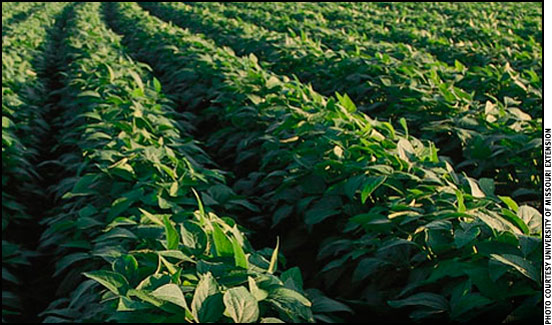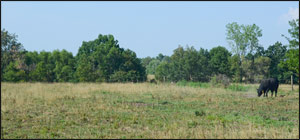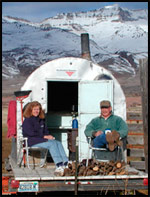MANAGEMENT...

Lush Green Soybean Fields
May Not be Good Sign
University of Missouri specialist says nutrients are in leaf, not pod.
Farmers are reporting that in spite of prolonged drought and hot temperatures their soybean plants appear amazingly green for this time of year.
"Green soybean plants may not be a good sign," says a University of Missouri (MU) Extension soybean specialist, "even though the plants appear to be thriving, compared to the brown and dead cornstalks in adjoining fields."
"They may have adequate moisture," said Bill Wiebold, of the MU plant science division. "More than likely, the green results from high nitrogen levels in leaves that have not converted into protein stored in seed pods." Read more.
Drought-damaged Soybeans Can Make Cattle Feed
University of Missouri economist has calculator for hay:bean value.
Soybeans that won't make a seed crop offer potential high-quality forage for beef and dairy producers. The decision to cut beans for hay won't be easy, say University of Missouri (MU) Extension specialists.
"It will be difficult to tell when there is no potential for a seed crop," said Bill Wiebold, MU soybean specialist.
"Waiting too late to cut soybeans for forage decreases feeding quality," said Justin Sexten, MU beef nutritionist.
Joe Horner, MU Extension economist, developed a spreadsheet for producers to put in their own numbers to figure value for forage. Read more.
 Time to Reseed Pastures
Time to Reseed Pastures
As with many of the state's crops, Kentucky cool-season forages have taken a hit from the drought and high temperatures. According to the Kentucky Weekly Crop and Weather Report released Aug. 13, more than half of the state's pastures were considered in poor or very poor condition.
August and September is the ideal time to reseed those pastures, said Ray Smith, extension forage specialist with the University of Kentucky College of Agriculture.
Before planting, producers should have their soil tested and fertilize according to the test's recommendations.
Read more.

Ron Torell with his wife, Jackie
Cow Camp Chatter
Self-disciplined ranch management needed.
Why does it take something like a drought or low cattle market to get the attention of those of us in the cow business? It was easy for us to become complacent with $1,200 yearlings, $900 calves and $1,000 market-ready cows. It seemed as if there would never be another bad day in the industry. With the cycle now moving in the opposite direction, we are thrust into a situation where forces outside of our control have brought on a downward trend and softer market. How do we deal with it? Read more.
Get Creative with Feeding Options
Producers look to nontraditional forages.
Producers who trucked in supplemental forages from further north last year will likely be out of luck this season thanks to the expansive drought. Many producers will be forced to get creative with feeding and grazing this year, said Justin Waggoner, Kansas State University (K-State) beef systems specialist, during the 2012 K-State Beef Conference Aug. 9. "We're probably going to have to make do with what we have," he said.
Waggoner advised producers to explore feeding nontraditional forages, such as crop residues or weeds. Most alternative forages have some associated risk, though.
"They are nontraditional for a reason," Waggoner said. Testing samples of forage for toxic substances helps assess the risk involved with feeding it. Read more.

Kris Ringwall
Beef Talk
Tips for how to survive the cattle business.
Summer is well under way. For those involved in the cattle business or any part of agriculture, for that matter, the clock is ticking. Successful summers mean bountiful falls and normal winters. Difficult summers mean problematic fall and winter challenges that ultimately may change the future of the farm or ranch. It is a fact of life that the beef business is struggling.
The call to expand the cow herd continues to be repelled by forces beyond a producer's control. Currently, drought is driving the industry, but producers need to reflect on what to do — not what we can't do.
What can we do? Read more.
New Products
Industry affiliates provide a wide array of products and services to assist you on the farm and ranch. Here's an assortment of new products to hit the market recently.
- Polyurethane boot
- More productive tractor
- Livestock trailer features, options offer advanced safety, convenience
- Durable, precise scales
- Upgraded loadalls
Angus Advisor
Click here for August herd management tips from cattle experts across the nation. Advice separated by region.
[Click here to go to the top of the page.]










